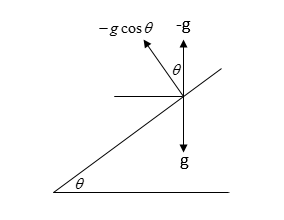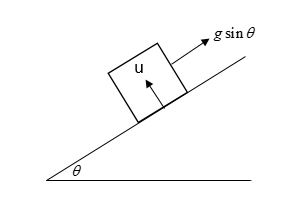Answer
372.3k+ views
Hint
First we need to consider the origin to be placed in the cabin and at the position from where the particle is projected. Then we need to divide the velocity into components parallel and perpendicular to the inclined plane. Then we need to find the resultant x and y components of the displacement. At last, we need to equate the respective equations and solve them to get the final equation.
$displacement = velocity \times time$
$S = ut + \dfrac{1}{2}g{t^2}$
Where, $S$ is displacement, $u$ is velocity, $t$ is time and $g$ is gravity
Complete step by step answer
In the problem, it is mentioned that the cabin is moved up the inclined plane with a constant acceleration$g\sin \theta $. Let's assume that the instantaneous velocity of the cabin travelling upward is ${u_1}$.Let's consider that the origin is set at the position from where the particle has been thrown upward perpendicularly to the inclined plane as shown in the image and its velocity is ${u_2}$. Now, we can draw the components of the velocity as follows:

Visually we can conclude,
Deceleration of the particle in the direction perpendicular to the inclined plane = $ - g\cos \theta $(negative sign to indicate the opposite direction of gravitational force).
Time to reach the maximum height perpendicular to the plane =$\dfrac{{velocity}}{{g\cos \theta }} = \dfrac{{{u_2}}}{{g\cos \theta }}$
The maximum height perpendicular to the plane = $\dfrac{{{{(velocity)}^2}}}{{2g\cos \theta }} = \dfrac{{{u_2}^2}}{{2g\cos \theta }}$
Displacement in the x-direction = $x$ = \[\left( {velocity{\text{ }}of{\text{ }}cabin{\text{ }}or{\text{ }}origin{\text{ }}in{\text{ }}x - direction{\text{ }}-{\text{ }}velocity{\text{ }}of{\text{ }}the{\text{ }}particle{\text{ }}in{\text{ }}the{\text{ }}x - direction} \right) \times \left( {time} \right)\]= $({u_1}\cos \theta - {u_2}\sin \theta ) \times t$ (here, $t$ indicated the time) ($\because displacement = velocity \times time$)
Displacement in the y-direction = $y$ =\[
\left[ {\{ \left( {velocity{\text{ }}of{\text{ }}cabin{\text{ }}or{\text{ }}origin{\text{ }}in{\text{ }}y - direction){\text{ + (}}velocity{\text{ }}of{\text{ }}the{\text{ }}particle{\text{ }}in{\text{ }}the{\text{ }}y - direction} \right)\} \times \left( {time} \right)} \right] \\
+ \dfrac{1}{2}g{(time)^2} \\
\]= $({u_1}\sin \theta + {u_2}\cos \theta )t - \dfrac{1}{2}g{t^2}$
For the ball to meet the inclined floor we can write = $y$ = \[\;x(tan\theta )\]
We can substitute the value of $y$ and we get = \[t{\text{ }} = {\text{ }}\dfrac{{\left( {2{\text{ }}{u_2}{\text{ }}Sec\;\theta } \right)}}{g}\]
After equating relative maximum height and range we can get,
$\dfrac{{{u_2}^2}}{{(2gcos\theta )}} = ({u_2}tan\theta + \dfrac{g}{{2Sin\theta }} \times \dfrac{{2{u_2}sec\theta }}{g})(\dfrac{{2{u_2}sec\theta }}{g})$
By Simplifying the above equation we get,
$\cot \theta = 8$
The value of the $\cot \theta $ is 8.
Note
When dividing the velocity into components we need to be careful about the value of the angle that the velocity is making with the plane of interest. We need to look for the proper plane about which we need to resolve the velocity components. Choosing the wrong plane will complicate the solution and might lead to catastrophe.
First we need to consider the origin to be placed in the cabin and at the position from where the particle is projected. Then we need to divide the velocity into components parallel and perpendicular to the inclined plane. Then we need to find the resultant x and y components of the displacement. At last, we need to equate the respective equations and solve them to get the final equation.
$displacement = velocity \times time$
$S = ut + \dfrac{1}{2}g{t^2}$
Where, $S$ is displacement, $u$ is velocity, $t$ is time and $g$ is gravity
Complete step by step answer
In the problem, it is mentioned that the cabin is moved up the inclined plane with a constant acceleration$g\sin \theta $. Let's assume that the instantaneous velocity of the cabin travelling upward is ${u_1}$.Let's consider that the origin is set at the position from where the particle has been thrown upward perpendicularly to the inclined plane as shown in the image and its velocity is ${u_2}$. Now, we can draw the components of the velocity as follows:

Visually we can conclude,
Deceleration of the particle in the direction perpendicular to the inclined plane = $ - g\cos \theta $(negative sign to indicate the opposite direction of gravitational force).
Time to reach the maximum height perpendicular to the plane =$\dfrac{{velocity}}{{g\cos \theta }} = \dfrac{{{u_2}}}{{g\cos \theta }}$
The maximum height perpendicular to the plane = $\dfrac{{{{(velocity)}^2}}}{{2g\cos \theta }} = \dfrac{{{u_2}^2}}{{2g\cos \theta }}$
Displacement in the x-direction = $x$ = \[\left( {velocity{\text{ }}of{\text{ }}cabin{\text{ }}or{\text{ }}origin{\text{ }}in{\text{ }}x - direction{\text{ }}-{\text{ }}velocity{\text{ }}of{\text{ }}the{\text{ }}particle{\text{ }}in{\text{ }}the{\text{ }}x - direction} \right) \times \left( {time} \right)\]= $({u_1}\cos \theta - {u_2}\sin \theta ) \times t$ (here, $t$ indicated the time) ($\because displacement = velocity \times time$)
Displacement in the y-direction = $y$ =\[
\left[ {\{ \left( {velocity{\text{ }}of{\text{ }}cabin{\text{ }}or{\text{ }}origin{\text{ }}in{\text{ }}y - direction){\text{ + (}}velocity{\text{ }}of{\text{ }}the{\text{ }}particle{\text{ }}in{\text{ }}the{\text{ }}y - direction} \right)\} \times \left( {time} \right)} \right] \\
+ \dfrac{1}{2}g{(time)^2} \\
\]= $({u_1}\sin \theta + {u_2}\cos \theta )t - \dfrac{1}{2}g{t^2}$
For the ball to meet the inclined floor we can write = $y$ = \[\;x(tan\theta )\]
We can substitute the value of $y$ and we get = \[t{\text{ }} = {\text{ }}\dfrac{{\left( {2{\text{ }}{u_2}{\text{ }}Sec\;\theta } \right)}}{g}\]
After equating relative maximum height and range we can get,
$\dfrac{{{u_2}^2}}{{(2gcos\theta )}} = ({u_2}tan\theta + \dfrac{g}{{2Sin\theta }} \times \dfrac{{2{u_2}sec\theta }}{g})(\dfrac{{2{u_2}sec\theta }}{g})$
By Simplifying the above equation we get,
$\cot \theta = 8$
The value of the $\cot \theta $ is 8.
Note
When dividing the velocity into components we need to be careful about the value of the angle that the velocity is making with the plane of interest. We need to look for the proper plane about which we need to resolve the velocity components. Choosing the wrong plane will complicate the solution and might lead to catastrophe.
Recently Updated Pages
Mark and label the given geoinformation on the outline class 11 social science CBSE

When people say No pun intended what does that mea class 8 english CBSE

Name the states which share their boundary with Indias class 9 social science CBSE

Give an account of the Northern Plains of India class 9 social science CBSE

Change the following sentences into negative and interrogative class 10 english CBSE

Advantages and disadvantages of science

Trending doubts
Which are the Top 10 Largest Countries of the World?

Difference between Prokaryotic cell and Eukaryotic class 11 biology CBSE

Fill the blanks with the suitable prepositions 1 The class 9 english CBSE

Differentiate between homogeneous and heterogeneous class 12 chemistry CBSE

How do you graph the function fx 4x class 9 maths CBSE

Select the word that is correctly spelled a Twelveth class 10 english CBSE

The Equation xxx + 2 is Satisfied when x is Equal to Class 10 Maths

Give 10 examples for herbs , shrubs , climbers , creepers

Change the following sentences into negative and interrogative class 10 english CBSE




